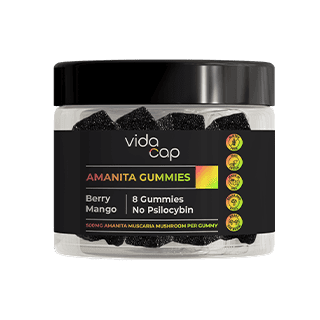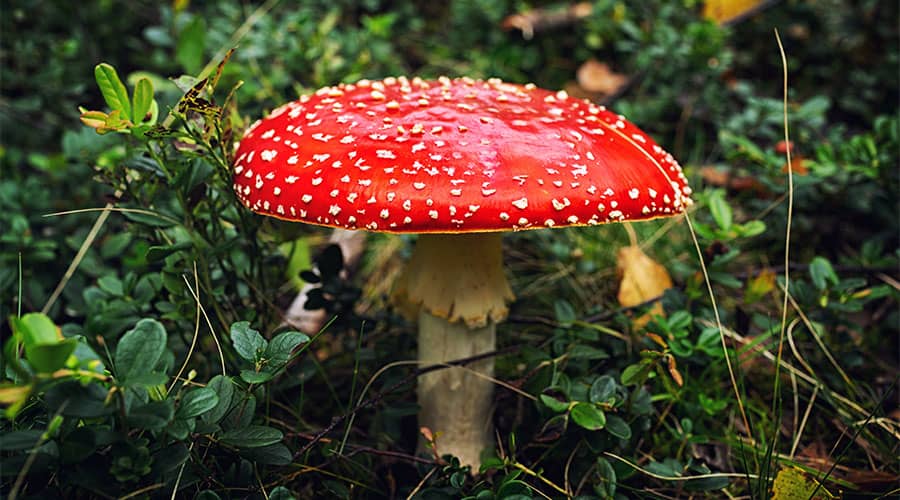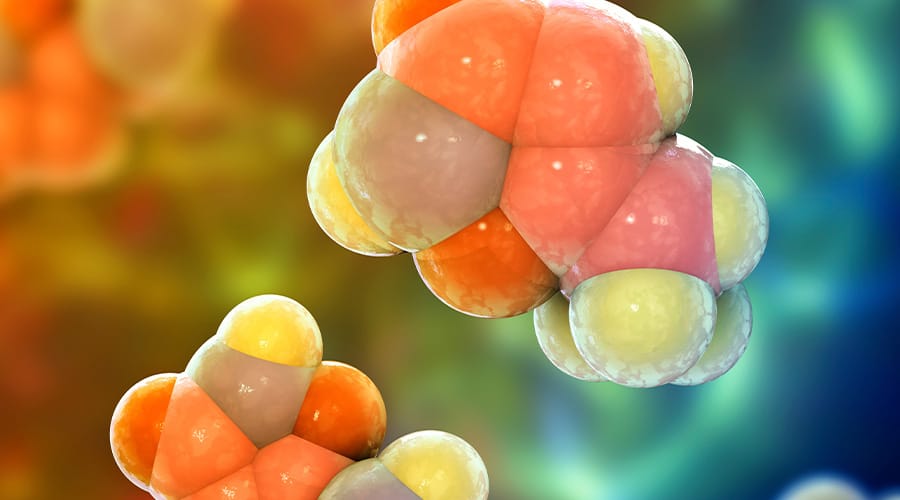While the Amanita muscaria mushroom has been used for hundreds of years, it has recently achieved mainstream status. Yet, there is much that the general public doesn’t know about the fly agaric mushroom.
For instance, some people mistakenly believe amanita contains psilocybin, the hallucinogen associated with magic mushrooms. Others assume that muscarine is the main active component.
In reality, muscimol and ibotenic acid are the main active compounds in this fascinating mushroom. The former is associated with many of amanita’s purported benefits. Thus, the assumption is that you should consume decarboxylated amanita with minimal ibotenic acid and maximum muscimol.
This article explores muscimol, outlining its effects, use in medicine, and safety considerations. It also investigates whether you should eschew ibotenic acid in favor of muscimol.

Amanita gummies are one of the most popular products on the market, but do you know what’s inside? With VidaCap, customers always know what to expect because the brand includes lab reports with its gummies. So, you can determine how much muscimol you consume with each piece.
What Is Muscimol?
Muscimol is one of the main psychoactive compounds found in amanita muscaria. It has a chemical structure similar to GABA, the well-known inhibitory neurotransmitter. Indeed, it is a selective orthosteric agonist for the GABAA receptors in the brain.
This means that muscimol binds to the GABAA receptors in the brain at a specific active site. Thus, it may help users relax, although there’s also a possibility that it will result in feelings of tranquility and euphoria. There is also a suggestion that it possesses neuroprotective properties.

If you pick fresh Amanita muscaria, it will have a high level of ibotenic acid. This compound is potentially neurotoxic, and most users prefer to steer clear. The process of converting ibotenic acid to muscimol means decarboxylating the mushrooms. Doing this involves drying the mushrooms, simmering them, and reducing the pH to between 2.5 and 3.
Reputable brands that sell amanita gummies and dried mushrooms should already have completed the “decarbing” process.
What Are Muscimol’s Main Effects?
The effects of muscimol aren’t yet fully understood. Hopefully, further research will reveal a great deal more. As things stand, we know that muscimol has psychoactive effects.
Some people make the mistake of thinking psychoactive and psychedelic are the same. In fact, a psychedelic compound (such as the psilocybin found in magic mushrooms) leads to unusual mental effects such as hallucinations.
In contrast, psychoactive substances can alter your brain in any way and do not necessarily lead to a “psychedelic” experience.
Commonly reported effects of muscimol include the following:
- Tranquility: A feeling of complete peace and quiet, as if you don’t have a single care in the world.
- Euphoria: This is when you feel an unusual degree of happiness, well-being, pleasure, or excitement.
- Lucid Dreams: When you have a lucid dream, it may feel as if you’re in control of the dream to the extent that it almost feels real.
- Relaxation: Individuals who consume muscimol sometimes feel extremely relaxed or tired. Therefore, amanita could prove a useful sleep aid for some.
- Synesthesia: This phenomenon involves your brain routing sensory information via various unrelated senses. So, you experience more than a single sense at once. For instance, you might taste citrus when you see the color yellow.
Muscimol’s Use in Medicine
There is great excitement amongst amanita proponents regarding the medicinal properties of muscimol. However, research into the compound’s potential therapeutic effects is currently limited.
Since it is an agonist to GABAA receptors, muscimol could benefit several mental and physical health issues, including pain, addiction, and insomnia.
A detailed review of studies published in Food and Chemical Toxicology in 2019 investigated the effects of amanita extract on different in vitro neurotoxicity models at cellular and sub-cellular levels.
It found evidence that muscimol could have suppressive effects on essential tremor, with no negative impact on coordination and speech. It also stated that the effects of the compound on patients with Parkinson’s are described in several studies.
As far as muscimol’s neuroprotective effects are concerned, the researchers investigated the compound’s impact on neurotoxicity models in rat brain microsomes, synaptosomes, mitochondria, and neuroblastoma cell line SH-SY5Y. Furthermore, they looked at the potential inhibitory effect of muscimol on the hMOAB (human recombinant monoaminoxidase-B) enzyme.
According to the researchers, amanita with a high muscimol content had “statistically significant neuroprotective effects on the in vitro neurotoxicity models and no inhibitory activity on hMAOB.”
Yet, we must wait for results from the different clinical trials taking place to ascertain the medical potential of muscimol.
Is Muscimol the Key to Amanita?
One of the main reasons why ibotenic acid is considered toxic is due to a study on rats from 1979. In it, researchers analyzed the effects of ibotenic acid when injected into the brains of rats. They found that the rats experienced a “marked disappearance of nerve cells in all areas studied.”
It is also suggested that ibotenic acid is responsible for amanita’s adverse effects. These may include dizziness, ataxia, agitation, and confusion.
Certainly, ibotenic acid’s effects on the brain differ from muscimol’s. It is linked with cell death and damage. So, the assumption is that consuming Amanita muscaria with a high ibotenic acid level is bad news.
Yet, it is entirely plausible that the worst-case scenario outlined by the rat study does not apply to human subjects. After all, you won’t inject ibotenic acid into your brain!
There’s no guarantee that completely removing ibotenic acid through decarboxylation will eliminate all adverse effects. Likewise, it isn’t certain that having 20-30% ibotenic acid and a 70-80% muscimol content will have negative side effects. Once again, research is necessary before making any concrete judgments.
Safety Considerations When Using Muscimol
With relatively little knowledge about muscimol’s effects, making assumptions one way or another is dangerous. If you research amanita online, you’ll doubtless come across scaremongering. When you Google “is muscimol safe,” you might find articles claiming that the mushroom is toxic and potentially deadly.

Certainly, there is research that doesn’t paint a pretty picture. One study published in 2021 referred to amanita as “The Deceptive Mushroom” and pointed out cases of poisoning. It suggested that “Amanita muscaria is a highly poisonous mushroom” and “symptoms may manifest with coma and in rare cases lead to death.”
It described the case of a 44-year-old man admitted to the emergency department with nausea, malaise, and altered consciousness.
Another study highlighted cases of toxicity amongst users of Amanita muscaria and Amanita pantherina. Adverse effects included GI upset and CNS depression.
Dosing and Preparation Matter
It isn’t known precisely how much muscimol and ibotenic acid one must consume to experience an effect. However, there is data that provides a ballpark estimate, although some of the research is from decades ago.
For instance, one detailed study on amanita’s toxicological and pharmacological profile found different estimates. The researchers mentioned a study from 1975 that suggested that 53mg of muscimol produced strong inebriation, while 93mg led to vomiting. Human volunteers felt the effects of the compound within an hour when they consumed between 7.5mg and 10mg or between 50mg and 90mg of ibotenic acid.
A 2013 study suggested that adults may experience psychedelic effects after orally consuming just 6mg of muscimol or 30-60mg of ibotenic acid.
So, if you plan to use amanita, buying it from a reputable seller is best. Such brands decarb the mushroom, producing more muscimol and less ibotenic acid. Of course, the jury is out on the optimal muscimol to ibotenic acid ratio.

Amanita gummies are one of the most popular products on the market, but do you know what’s inside? With VidaCap, customers always know what to expect because the brand includes lab reports with its gummies. So, you can determine how much muscimol you consume with each piece.
Final Thoughts on Muscimol
Ultimately, there’s a lot left to uncover regarding the Amanita muscaria mushroom. Researchers continue to investigate the benefits and effects of muscimol and whether it’s best to fully decarb amanita to remove as much ibotenic acid as possible.
As things stand, it is believed that amanita with a high muscimol content is best. Thus, if you intend to buy products such as amanita gummies, only use brands that provide updated lab reports outlining the muscimol content. While muscimol has plenty of promise, it is wise to use only a small amount of amanita at first to see how it affects you.









